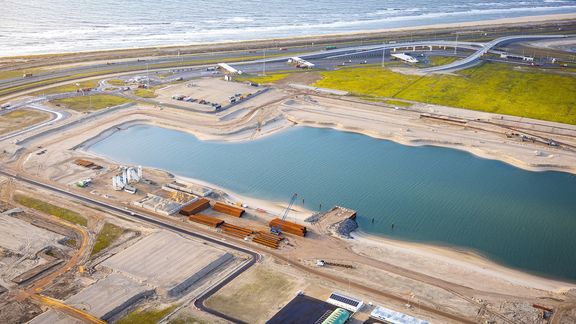Amaliahaven quay wall construction gains momentum
A new part of the Netherlands is gradually taking shape in the Prinses Amaliahaven on Maasvlakte 2, In all, 1,825 metres of deep-sea quay, 160 metres of inland waterway quay and 360 metres of earth-retaining structure will be built on both sides of the port that stretches approximately 2.5 kilometres. This makes it currently the largest construction project in the port of Rotterdam.
Time to have a look behind the scenes...
Fred Attema of Ballast Nedam describes the work as a ‘fantastic job’. As Chief Civil Engineer, he is responsible for the substructure of the quays; everything under the concrete. From foundations and piles to sheet piles. ‘Spending all day working with water, sand and concrete. What could be better than that?’ If he has to come up with one downside to the job, then it is the daily commute. Laughing: ‘You’re quite close to England here, aren’t you?’
In February 2021, a consortium consisting of HOCHTIEF, Ballast Nedam and Van Oord was awarded the mega-contract by the Port of Rotterdam Authority. Anticipating further growth, the construction of these new quays could lead to four million more containers (TEU) being handled in the port of Rotterdam each year. And that, on top of a total of 15 million containers in 2021, represents a considerable increase in capacity.
CO2 dashboard
Besides quality, price and construction time, the three companies can also attribute their winning bid to their focus on sustainability. Attema: ‘For example, we have a detailed CO2 dashboard that monitors emissions from each individual machine. We therefore use electric loaders and excavators wherever we can, we use green power and renewable power from the solar panels on the site office. Whenever we use fuel, it is Hydrotreated Vegetable Oil (HVO). This produces 89 per cent less CO2 than diesel and also emits lower amounts of particulates, nitrogen and sulphur.’

Van Oord handles the dredging and earthmoving work. Eric Bouman is on the project management board of this Rotterdam-based company. ‘Van Oord currently has around twenty employees working on this job. Once the dredging starts, this number quickly rises to a hundred, and we work 24/7.’ The cutter suction dredger ‘Biesbosch’ then removes sand to a depth of twelve metres, after which a suction hopper dredger takes care of the final part, down to twenty metres. Bouman: ‘The good sand will be reused in the Prinses Alexiahaven. The rest will be disposed of at sea. Incidentally, you can see the sector’s transition to sustainability in action here too; for example, the ‘Biesbosch’ is powered by biofuel.’
Sections
The quays are constructed in 25-metre sections, the quay wall consisting of tubular piles that measure 1.40 metres in diameter, with 1.80-metre sheet piling in between. Together with the grout anchors, 1,150 inclined vibro piles ensure that the quays can withstand the forces of the mooring ships. A similar number is used to support the tracks for the loading cranes. Driving these piles in is the speciality of Mesut Oğuz from HOCHTIEF. ‘The piles we use measure up to 36 metres in length. We’re talking foundation engineering at Champions League level. Another interesting fact is that we are going to fit some of them with fibre-optic cables full of sensors. This will allow real-time monitoring of the forces exerted on the structure during free dredging and when ships berth at the quay wall.’
A similarly smart solution will be installed on the quays. In this case, smart bollards will measure the strain on the mooring lines. When force is applied to a bollard, it moves very slightly. A sensor measures the force and sends the results directly to the Port of Rotterdam Authority. This not only allows the continuous monitoring of safety but also provides clearer insight into which vessels can moor at which quays.
Biodiversity
Finally, let’s remind ourselves of the innovation that will be taking place underwater. So-called ECOncrete blocks will be installed at two locations. These will act as artificial reefs to stimulate underwater biodiversity. However, that project will pretty much be the culmination of the work. For the time being, construction is still a relatively early stage. Oğuz: ‘In the first quarter of 2021, we started the preparatory work: building roads, site offices and a warehouse. We also built a temporary quay so a large amount of the materials could be supplied by barge. This saves us around 20,000 truck movements. Not only is this much more sustainable, but it also saves a lot of congestion on the construction site and the surrounding road network.’